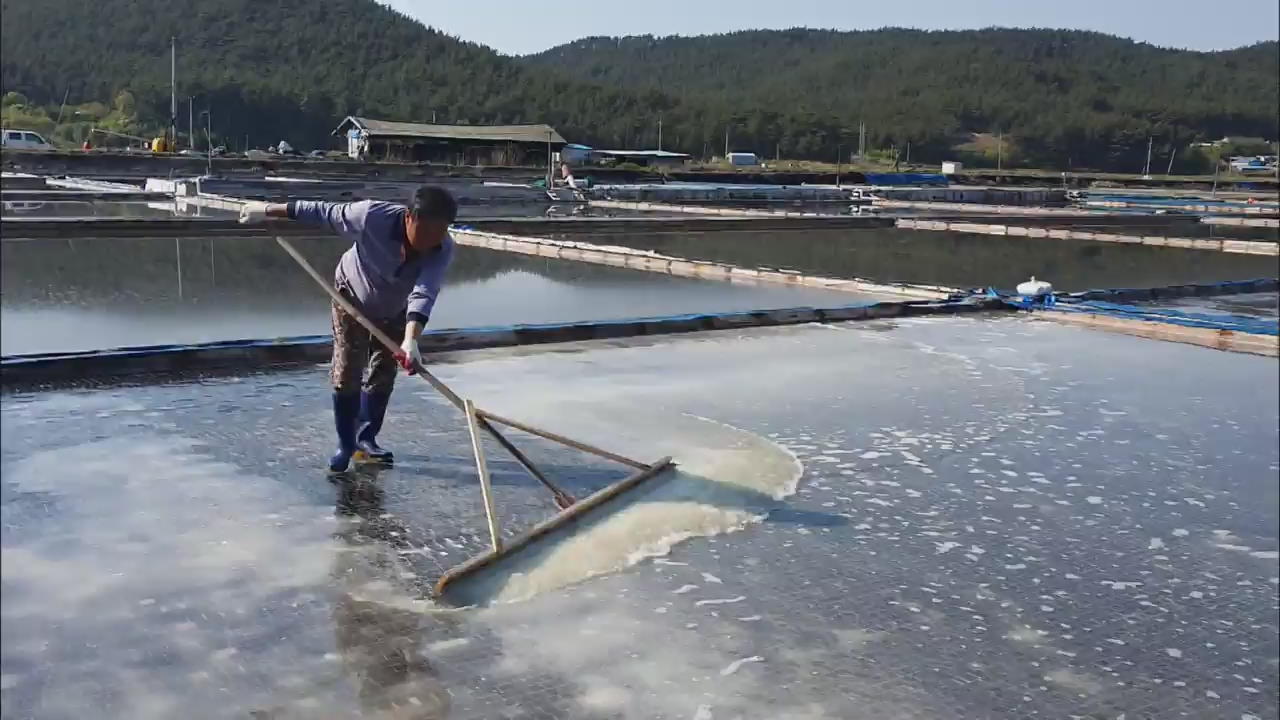PINE POLLEN
입력 2019.05.10 (15:04)
수정 2019.05.10 (16:52)
읽어주기 기능은 크롬기반의
브라우저에서만 사용하실 수 있습니다.
[Anchor Lead]
Pine pollen causes haze during this time of the year, prompting complaints from people suffering from allergies. But pine pollen is a key ingredient in making high-end salt in Korea.
[Pkg]
Workers sweep up salt at a vast salt field. Salt is piled up higher with every scrape of a shovel. But the color is light yellow instead of the usual white. This type of salt is created when pine pollen falls naturally into the salt fields. Pine pollen salt can be produced for only about a week in early May, when the pollen is released.
[Soundbite] HAN SANG-BOK(SALT MAKER) : "We are busiest in early May because we have to collect the pine pollen."
Taean Peninsula is the best location to collect pine pollen, since pine trees cover 90% of the region's forest. Modest production and subsequent scarcity made the pine pollen salt a high-end specialty. Orders pile up around this time of the year, since the pine pollen salt is known to be rich in vitamins and minerals and produce a unique flavor when used together with fermented foods like soybean paste or spicy pepper paste. Pine pollen is demeaned in the cities as a cause of springtime allergy, but at salt fields it is regarded as a valuable ingredient for a rare product.
Pine pollen causes haze during this time of the year, prompting complaints from people suffering from allergies. But pine pollen is a key ingredient in making high-end salt in Korea.
[Pkg]
Workers sweep up salt at a vast salt field. Salt is piled up higher with every scrape of a shovel. But the color is light yellow instead of the usual white. This type of salt is created when pine pollen falls naturally into the salt fields. Pine pollen salt can be produced for only about a week in early May, when the pollen is released.
[Soundbite] HAN SANG-BOK(SALT MAKER) : "We are busiest in early May because we have to collect the pine pollen."
Taean Peninsula is the best location to collect pine pollen, since pine trees cover 90% of the region's forest. Modest production and subsequent scarcity made the pine pollen salt a high-end specialty. Orders pile up around this time of the year, since the pine pollen salt is known to be rich in vitamins and minerals and produce a unique flavor when used together with fermented foods like soybean paste or spicy pepper paste. Pine pollen is demeaned in the cities as a cause of springtime allergy, but at salt fields it is regarded as a valuable ingredient for a rare product.
■ 제보하기
▷ 카카오톡 : 'KBS제보' 검색, 채널 추가
▷ 전화 : 02-781-1234, 4444
▷ 이메일 : kbs1234@kbs.co.kr
▷ 유튜브, 네이버, 카카오에서도 KBS뉴스를 구독해주세요!
- PINE POLLEN
-
- 입력 2019-05-10 15:08:37
- 수정2019-05-10 16:52:44

[Anchor Lead]
Pine pollen causes haze during this time of the year, prompting complaints from people suffering from allergies. But pine pollen is a key ingredient in making high-end salt in Korea.
[Pkg]
Workers sweep up salt at a vast salt field. Salt is piled up higher with every scrape of a shovel. But the color is light yellow instead of the usual white. This type of salt is created when pine pollen falls naturally into the salt fields. Pine pollen salt can be produced for only about a week in early May, when the pollen is released.
[Soundbite] HAN SANG-BOK(SALT MAKER) : "We are busiest in early May because we have to collect the pine pollen."
Taean Peninsula is the best location to collect pine pollen, since pine trees cover 90% of the region's forest. Modest production and subsequent scarcity made the pine pollen salt a high-end specialty. Orders pile up around this time of the year, since the pine pollen salt is known to be rich in vitamins and minerals and produce a unique flavor when used together with fermented foods like soybean paste or spicy pepper paste. Pine pollen is demeaned in the cities as a cause of springtime allergy, but at salt fields it is regarded as a valuable ingredient for a rare product.
Pine pollen causes haze during this time of the year, prompting complaints from people suffering from allergies. But pine pollen is a key ingredient in making high-end salt in Korea.
[Pkg]
Workers sweep up salt at a vast salt field. Salt is piled up higher with every scrape of a shovel. But the color is light yellow instead of the usual white. This type of salt is created when pine pollen falls naturally into the salt fields. Pine pollen salt can be produced for only about a week in early May, when the pollen is released.
[Soundbite] HAN SANG-BOK(SALT MAKER) : "We are busiest in early May because we have to collect the pine pollen."
Taean Peninsula is the best location to collect pine pollen, since pine trees cover 90% of the region's forest. Modest production and subsequent scarcity made the pine pollen salt a high-end specialty. Orders pile up around this time of the year, since the pine pollen salt is known to be rich in vitamins and minerals and produce a unique flavor when used together with fermented foods like soybean paste or spicy pepper paste. Pine pollen is demeaned in the cities as a cause of springtime allergy, but at salt fields it is regarded as a valuable ingredient for a rare product.
이 기사가 좋으셨다면
-
좋아요
0
-
응원해요
0
-
후속 원해요
0












![[속보] 법원, 이재명 대통령 ‘법카 유용 의혹’ <br>재판 연기…기일 추후 지정](/data/news/2025/07/01/20250701_M11rp4.jpg)
![[속보] 검찰 고위간부 인사…<br>중앙지검장 정진우·동부지검장 임은정](/data/layer/904/2025/07/20250701_nl3Pv7.jpg)



이 기사에 대한 의견을 남겨주세요.